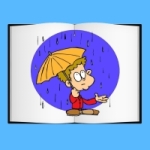
 |
Nursery Rhymes |
This is a delightful book for preschoolers. At each turn of the page it has a different nursery rhyme with colourful graphics and engaging sounds.
Children do not need to be able to read, as the rhyme is read to them. They can have fun clicking on the speaker icons to have the rhyme reread and the sounds replayed.
Pages can be turned forwards and backwards by clicking on the turned corner at the bottom of the pages. Children can also use click and drag in the direction of the arrow. This makes the reader feel like they are turning the page of a real book.
To exit, click on the small hand in the upper right corner of the screen.
Outcome 2: Children are connected with and contribute to their world
Outcome 4: Children are involved and confident learners
Outcome 5: Children are effective communicators
Understand that print carries meaning
Enrich vocabulary
Relate images to text
Listening for rhyming sounds in words
Programme navigation
Mouse control - single click
Children love being told nursery rhymes and some families pass them on from generation to generation. The lyrics may have changed a little over the years, but the ones in this book quote the original words. Most of the rhymes are quite old with some dating back to 16th century England.
Some rhymes have tunes to go with them, such as Hey diddle diddle.
Most people will know the fun "This little piggy". Each "piggy" relates to each child's toe and results in a tickling by the narrator. It was first published in 1728.
"Horsey, horsey" is not so well known. It introduces to children onomatopoeic words. These are words which sound like their meaning. Clippetty clop and swish are the ones used here. Other examples are zip, pop, sizzle and splash.
The origins of the "Pussycat, pussycat" rhyme date back to 16th century Tudor England. One of the ladies-in-waiting to Queen Elizabeth 1st had an old cat that roamed throughout the castle. On one occasion the cat ran beneath the throne where its tail brushed against the Queen's foot, startling her. Luckily the Queen had a sense of humour and decreed that the cat could wander about the throne room, on condition it kept it free of mice!